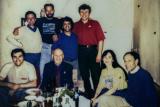Folders |
At 75, Marc Bloom Made A Winning Plan And Won A USATF Master's TitlePublished by
The Blossom Training System:A High School Track Nickname Spurs A Victory For The AgesBy Marc Bloom For most runners, serious training is based on hard physiological principles, time-tested theory, sacred understanding of stress and recovery and treasured concepts from the sages passed down through the ages. We runners take pride in tossing around fancy terms like “lactate threshold” and typically monitor our efforts in percentage of “max.” There’s nothing wrong with that, but when I set about training for the recent USA Masters Indoor Track and Field Championships at the New York Armory, I chose a different approach. I used the “Blossom” Training System. You’ve heard of Lydiard, Cerutty, Bowerman, Daniels — the namesakes of various methodology runners and coaches have come to rely on. But, Blossom? Blossom was my nickname on the high school track and cross-country team in early 1960s Brooklyn. Y’know… Bloom… Blossom. Like any shrewd coach, ours, at Sheepshead Bay High School, had nicknames for us. One guy was called “Goose” because of his long neck. Another, our best distance runner, was called, “The Animal.” He did crazy things like run on his own on weekends. Another boy, whose first name was “Lane,” was anointed “Boulevard.” Team members took pride in their monikers. Not me. Blossom seemed too delicate for my taste. And when the coach, while I competed at the Armory, would call to me, “C’mon, Bloom… Blossom!” and I never would, this letdown became my calling card. In a way, Blossom doomed my high school career, and the memory of that has never been far from my psyche in a lifetime of adult running. While proud of running into my 70s, I’ve never really measured up to racing goals I set for myself. When the 2022 masters event was awarded to my old stomping grounds — the illustrious Armory in the Washington Heights section of upper Manhattan — I decided to take a crack, perhaps one final crack at 75, at making up for my own ignominious version of a misspent youth. Since all the many training approaches I’d tried in 50 years of running had not produced the results I wanted, I decided to look for something new. But I realized there was nothing new based on science, especially for someone of my age. My training adventure would have to come from a different, more creative realm — the realm of art. When you think about it, even the most science-driven training has some element of art to it. But what does that mean, “art” in training? I considered it as a free-flowing, no rules, perhaps audacious attempt to push the envelope, without regard to what I was “supposed” to do, but what felt more intuitive, right for that moment. If you’re going to throw out the rulebook, 75 seemed like a good age to start. The Blossom Training System would be counter-intuitive above all else. The more I thought more about it, I wondered if the high-level training that we often hear about has become a tad too programmed and could use more contrariness in the striving for success. Perhaps all the fuzzy math and inflated importance of what I would consider flawed laboratory studies have detracted from what might be considered faithful old school: go with your gut. I went with my gut. I had valuable personal antecedent for my new creation: experience working with teenagers, where “art” more than anything plays a critical role. As a young man, when I got out of college, I did some teaching in a New York middle-school. I knew my subject, English and creative writing, but the first semester the kids buried me. I flunked classroom management. I was like Sidney Poitier starting out with a class of roughnecks in “To Sir, With Love.” With youngsters, you can throw out your resume. Poitier’s character realized that, revamped his approach and succeeded. I would too, and this artistic sensibility would serve me well in my later high school coaching years. It seemed that whenever I confronted a challenging task, a tapestry of “rich and royal hue,” as Carole King sang it, would play some role in a positive outcome. USATF MASTERS INDOOR CHAMPIONSHIPS ON-DEMAND VIDEOS (+PLUS subscription required) My event at nationals would be the 3,000 meters, 15 laps around the Armory’s banked, 200-meter track. At 75, I would race in the 75-79 age-group. Gentlemen runners would come in from all over the country. No matter how fit I might get, I knew I could not take anything for granted. I’d run one USA masters indoor meet about a decade earlier, in Landover, Maryland, competing in the 3,000 and mile on successive days, earning a bronze medal in the former. But that was Maryland. I wanted the Armory. The Armory was Broadway: indeed, it was situated one block from Broadway, on 168th Street, about six miles north of the Theatre District. After all these years, I craved my pound of flesh. In high school I ran the 440 yards — the “quarter” — and mile relays. I never came close to winning anything. My experience at the Armory was one of fear, getting my stuff stolen, dropped batons, vomiting after races and late nights. Oftentimes, I felt I should have taken friends’ advice and joined the school bowling team instead. In junior leagues at the local alleys, I shot several big scores, collecting one trophy after another. My take at the Armory: zilch. I decided that Blossom would have to be an all-or-nothing approach. Simply put, I would run as hard as I could as often as I could, convention — and age — be damned. My greatest asset was consistency. I never missed time for injury and had built a huge base to work off. For 10 weeks — January, February and half of March leading into the March 18 race — I would adhere to pretty much the same menu of strenuous workouts I’d dished out to those I’d coached who were young enough to be my grandchildren: short and long repeats, tempo runs, hills, an occasional long run and various combinations to get the greatest bang for my buck every time out. I live in Princeton. N.J. and would use the University facilities as always: the outdoor track, turf fields, nearby dirt trails, a treadmill at my gym and hilly roads through and near campus. My only plan was: what could I accomplish today, and how fast could I recover for the next hard one. All workouts would be preceded by a 20-25 minute warm-up with stretching and 5 x 100 striders, and end with a 10-15 minute cool-down, stretching and striders. My attempt to test the limits of a 75-year-old runner steeped in holding onto the avidity of youth, went like this: Tempo Workouts: -- 3 miles on the track in 23 minutes, 7:40 mile pace, plus 4 x 40-second sprints on a turf field. -- 15 laps of an approximate 350-meter turf field, average 1:45 per lap, about 26 minutes, a little more than 5k. -- 5-miler on hilly road course in 38:30. -- Continuous circuits of l lap each of track and two turf fields for 45 minutes, 8:15 to 8:30 mile pace. Repetition Workouts: -- 10 x 300 meters on the track with 90-second jog recovery, average 73 seconds; jog 5 minutes; then 2k on the track in 9:30. -- 3 sets of l, 2, 3 and 4 laps around 350-meter turf field, 90-second recovery between runs, 3-minute recovery between sets, from 1:30 to 1:45 per lap, total 30 laps, a little more than a 10k. -- 2k on dirt trail in 9 minutes, 2-minute recovery; 2 x 1k in 4:20 each with 90-second recovery. Hill Workouts: -- 10 x approximate 2-minute road hill, jog back down for recovery, times from 1:55 to 1:45. -- At nearby park, 10 x steep 40-second grass hill, jog down; 5 x steep 80-second grass hill, jog down; 4 x moderate 60-second road hill, jog back to start. Treadmill Workouts: -- 5 x 30 seconds in 6:40 to 6:20 pace with 90-second recovery; jog 5 minutes; 10 minutes from 7:08 to 6:44 pace; jog 5 minutes; 5 x 45 seconds in 6:20 to 6:10 pace with 75-second recovery. -- 5 x 30 seconds in 6:40 to 6:20 pace with 90-second recovery; jog 5 minutes; 4 x 3:30 with 2:30 recovery like this: 1st rep: 7:08 to 6:58; 2nd rep: 7:03 to 6:53; 3rd rep: 6:58 to 6:49; 4th rep: 6:53 to 6:44; jog 5 minutes; 3 x 2 minutes at 6:40, 6:35, 6:30, with equal recovery; jog a few minutes; 4 x 1 minute from 6:30 to 6:18 with 90-second recovery. LSD Workouts: -- Conversational pace for 80 to 90 minutes, done once a month. Recovery Workouts: -- On the one or two days’ break between workouts, I did: 1 hour lap swimming/pool running; or 1 hour jog; or weight training, mostly upper body, plus box jumps and jumping rope. Last Workout One Week Prior to Race: -- Ladder on the track: 200, 300, 400, 600, 800, 600, 400, 300, 200, 2 x 100, total 4k. Times: 47, 75, 1:40, 2:37, 3:34, 2:35, 1:39, 73, 46, 21, 20. I felt good, strong… complete. My recuperative powers had shone through. At 75, I had defied conventional wisdom with operatic thunder and survived. Bring on the Armory! Race day was a Friday, opening day of the three-day championships, being held at the Armory for the first time. Warming up on the sidewalks, weaving through employees on lunch break from the massive New York-Presbyterian hospital complex across the street and resident Dominicans doing their weekend shopping for tostones and pollo guisado, I felt jitters. I told myself, you’re 75, who cares? But I’ve always been my own toughest critic; I feared harsh judgement if I didn’t run well. Plus: look at all that work I’d put in. Inside, on the warm-up straightaway below track level for sprinters, I practiced deep breathing and used visualization after doing my final striders. I told myself, go out slow, you’ve got 15 laps, don’t be rash. Start with a controlled first 1,000 meters, then try and race with unrelenting gusto like the high school kids had done the week before. The prior weekend, the New Balance high school nationals at the Armory were a blizzard of dazzling performances, led by the incomparable runners from Newbury Park High School in southern California. The Panthers boasted four runners — two sets of brothers — whose individual PRs averaged close to a 4-minute mile. Their 4xMile relay team shattered the all-time high school record by 32 seconds in 16:29.31. I could take a bit of proprietary pride in that. Soon after high school, in the mid-1960s, I started covering Armory meets for The New York Times and other newspapers while compiling stats and records and publishing annual performers’ lists, elevating the sport’s profile. In the late ‘80s, my Times Op-Ed column on a seemingly intractable dispute at the Armory, where meets then shared space with a city homeless population, caught the eye of Dr. Norb Sander, the 1974 New York City Marathon winner and athletes’ advocate. Sander sprang into action and went on to create the new Armory — the world-famous track palace that exists today. A journalism award of mine hangs in the media room a few feet from the state-of-the-art Mondo track.
Shaheed is also renowned in his profession as a trumpet player who has worked with everyone from Frank Sinatra to Count Basie, Marvin Gaye to Stevie Wonder to Ray Charles. The man is one cool cat, and at the crack of the gun he shot out to let you know who was boss. Two other 70 guys trailed him. In masters racing, you wear not only your race number on the front of your jersey but the number of your age-group on the back so opponents can identify you. A pair of 75 runners darted out ahead of me. I knew them both. One told me before the race that he was not in shape and “training for outdoors.” He did look a little heavy. The other was over 6 feet, reed thin and a national-class runner in his salad days. He and I both ran for Shore Athletic Club of New Jersey. Based on my training, I thought I could run 7-minute pace if I had to; but this was no time trial, I had to race people. Small field, runners long in the tooth and short of stride, grooving to Motown in their retirement communities — is that an “oh please” I hear from the Tik Tok crowd? Don’t knock it — we’re no less hungry or guileful or “serious” than you young colts, only slower. And we’ve gone some ways at “defeating” age, or at least aging, so that when your time comes you’ll know it can be done. None of us sits on the couch for very long. As I passed my out-of-shape rival after a lap, he graciously called out, “Go, Marc,” and I hastened to gradually pull up to my club-mate in another lap, sitting behind a man who had six inches on me as though I were drafting from the wind. I told myself, sit tight, move after 1k. I brushed by him at that precise point, after five laps. He offered little resistance and I pulled away feeling inspired and boundless with all those solid workouts in my system, one after another, a deserved accrual like that of a chef who’s been in the kitchen all day and is poised to plate. My '75' comrades fell further back and, realizing I could win, started to enjoy myself. Racing at the Armory and enjoying it: that’s what I wanted all along. No fear, no stolen gear, no vomiting. I decided to maintain pace, preserve the victory if I could, and coast untroubled to the finish. Oh, the joy, the bliss… so this is how winning feels! I crossed the line in 14:04.99 to triumph by 53 seconds, defeating my three opponents plus two from the 70 group, and become national 75-79 champion. My three-month odyssey was over. I didn’t drop the baton. After jogging it off, I embraced Shaheen, the 70-74 winner, in 12:24.40, while putting out little more than a training effort, and we shared some laughs and talked about the music legends he’d known. Comparing notes on the late Sam Cooke whom we both cherished, I thought of Cooke’s most enduring tune, “A Change is Gonna Come.” I walked out of the Armory and into the Heights clutching my USA national champion patch and feeling a rare glow. Friday night had arrived and Latin music could be heard from the street corners of Broadway. It had been a warm late-winter day, spring was in the air and the stirrings of life were about to blossom. # Marc Bloom has been writing about track and field, cross-country and running in general since the 1960s. His latest book, “Amazing Racers: The Story of America’s Greatest Running Team and Its Revolutionary Coach,” about the Fayetteville-Manlius dynasty, was named 2019 Book of the Year by the Track Writers Association of America. More news |

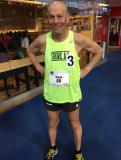
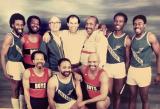
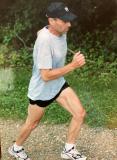

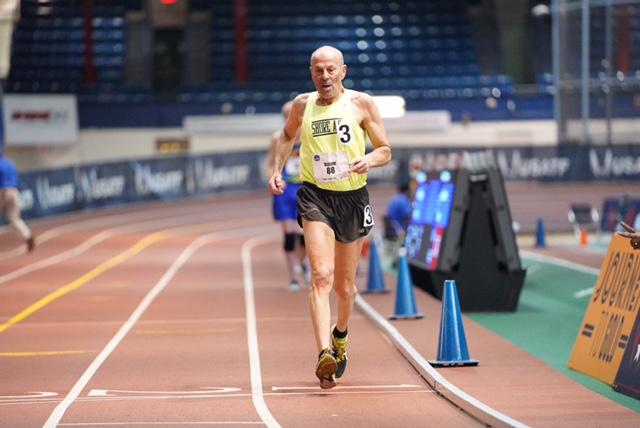 But none of that mattered as I stepped to the start and took my last sips of water. Officials combined the 70-74, 75-79 and 80-84 groups. There were nine men in the field. Each five-year age-group would be scored separately. The overall winner was a foregone conclusion: Nolan Shaheed, 72, of California, who has set at least 18 American and world age records from the 800 to the 3,000. Shaheed’s records included world 60-64 marks in the 800, 2:05.56, and 1500, 4:24.00. He’s 5-foot-9 and 125 pounds and eats like a bird. I’m 5-9 and 145 pounds and never refuse seconds.
But none of that mattered as I stepped to the start and took my last sips of water. Officials combined the 70-74, 75-79 and 80-84 groups. There were nine men in the field. Each five-year age-group would be scored separately. The overall winner was a foregone conclusion: Nolan Shaheed, 72, of California, who has set at least 18 American and world age records from the 800 to the 3,000. Shaheed’s records included world 60-64 marks in the 800, 2:05.56, and 1500, 4:24.00. He’s 5-foot-9 and 125 pounds and eats like a bird. I’m 5-9 and 145 pounds and never refuse seconds.